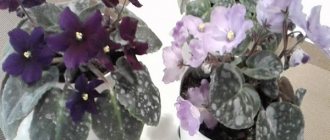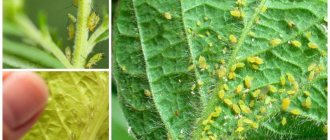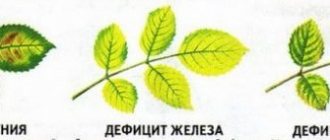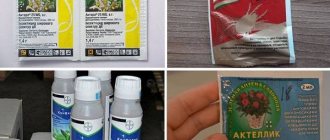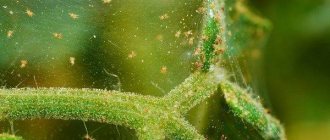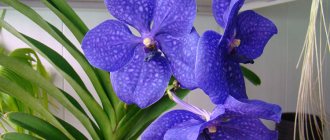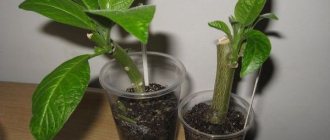Many flower lovers have violets. And almost everyone has encountered various problems in caring for them: diseases, parasites, pests.
One of the common pests that is found not only on violets is aphids.
If aphids appear on violets, what should you do? First of all, you should understand the reasons for its occurrence and ways to eliminate it.
Reasons for appearance
Aphids are natural inhabitants of the natural environment. It attacks violet leaves, preferring the inner side. The stems and flowers of plants are not left unattended. Numerous small insects, not exceeding two millimeters in length, cling to the flowers, feeding on their juice.
The appearance of these insects on violets does not occur without a reason, and is associated with the growing conditions of the crops. Insects appear on flowers growing in open ground in the garden due to the following circumstances:
- improper agricultural technology - untimely and poor-quality processing of crops, lack of care;
- aggressive environment in the growth zone - disruption of the ecological system, the spread of ants that carry aphids and contribute to their reproduction.
Pests, along with garden flowers, affect indoor flowers. Insects are not embarrassed by the limited number of objects of attack and the closed environment.
It is difficult to completely eradicate aphids in the garden. The gardener needs to regularly check the plants and take preventive measures to prevent the spread of pests. But in the situation with indoor flowers, aphids are not difficult to destroy completely and irrevocably.
Woodlice
With high humidity in the room and frequent waterlogging of the substrate, woodlice settle in pots with violets. Woodlice are tiny white land-dwelling crustacean insects. They look like small armadillos. In moist and loose soil they multiply quickly and damage the roots and leaves of violets. Their presence is especially dangerous for still young, immature plants. In old houses and basements, where dampness prevails, woodlice can still be found today. Perhaps some individuals have made their way into your home.
Drugs - acaricides, of which there are a large number in special stores, will help destroy woodlice from violets. Purchase the appropriate preparation and carry out the treatment (spraying the plant and watering the substrate) in accordance with the instructions.
Routes of infection
Infection with aphids occurs in the following ways:
- natural distribution of insects during the process of reproduction and dispersal. Pests migrate from surrounding crops - winged females fly from neighboring gardens, laying eggs;
- insects are brought by gardeners on seedlings of other plants planted on the site;
- with brought soil containing deposited larvae;
- through ants that spread aphids and increase the number of insects. Ants feed on the sticky sweet secretion secreted by aphids, so they treat it like a pet, transferring it to free plants and protecting it from the encroachments of competitors.
Pests are able to penetrate the closed ecosystem of indoor crops with a new flower when replacing the soil. The massive reproduction of aphids makes it one of the most dangerous pests for garden and indoor plants.
Symptoms
Even a novice gardener can easily recognize an infestation. The appearance of aphids can be recognized by the following characteristic signs:
- general wilting of the plant;
- numerous white, black or green tiny dots on the inside and then the outside of leaves, stems, buds;
- sticky liquid resembling sweet dew and covering the surface of the flower - subsequently a sooty fungus settles in these areas of the plant;
- tiny white scales remaining from hatched larvae;
- leaves curl, darken, become limp;
- the upper young shoots become deformed and dry out;
- the flowers take on ugly shapes, the violet stops throwing out new buds.
In addition to the direct harm associated with the loss of internal juices by the plant, aphid infestation threatens with the following unpleasant consequences:
- In the process of life, insects secrete a sticky enzyme that promotes the development of fungal diseases;
- attracting other pests - ants, mites;
- the occurrence of viral diseases in horticultural crops.
In case of severe infection, the plant stops blooming, withers, and after a few days it dies if the owner does not take emergency measures to combat the scourge.
Ticks
In a dry, hot room, various types of mites are frequent guests of indoor violets. Below are the signs of a tick and photos of different types.
Red spider mite
- So, you will detect the appearance of a red spider mite by red dots and thin cobwebs on the leaves of the plant. The leaves curl and fall off.
Spider mite
- You can recognize a common spider mite by its heavily cobwebbed leaves with brown indentations on the surface. As a result of its vital activity, violet leaves become brittle, darken and fall off.
Cyclamen mite is visible only under a microscope
- Cyclamen mites like to settle on young leaves in the center of the rosette. They suck the juice from the leaves, causing them to become deformed and covered with yellow spots. The flower stops growing, the stem bends and becomes shorter, the leaves curl and die, the buds become deformed and do not open.
This may be interesting: Lantana - description, types and varieties
If parasites are detected, we advise you to take the flower pot to the bathroom and try to wash off the insects under the shower. However, it will not be possible to cope with all individuals and their larvae using this method alone. For a complete guarantee, you will have to treat the violet with chemicals - insecticides. There are universal remedies for a complex of pests - “Fitoverm” or “Aktellik”. Treatment involves spraying the leaves and watering the soil two to three times at weekly intervals (read the attached instructions).
How to fight at home?
The effectiveness of measures depends on the timeliness of the treatment and the extent of the infection. It is important to carefully and regularly inspect crops so that you can begin to fight at the first sign of pests.
Control methods are selected taking into account the growing conditions of violets. Some chemicals are not suitable for indoor flowers due to their high toxicity, which is dangerous for people in confined spaces. At the initial stage or as a preventive measure, folk remedies will help, but they will be powerless when pests spread. Considering that aphids are extremely fertile, when they appear on violets, there is a real threat to the rest of the plants in the garden or on the common windowsill in the room.
Learn more about how to fight aphids on violets at home.
Mechanical removal
If pests are detected, and the infestation has not yet become widespread, aphids can be removed mechanically:
- insects are collected by hand;
- the affected shoots break off;
- for indoor flowers - the leaves are washed with a warm soapy solution, the plant is dried in a warm place.
When the aphids are removed, the plant and surrounding soil are treated using special products.
An alternative way to remove pests is to attract natural enemies of aphids. This insect is present in the diet of ladybugs, hoverflies, some species of wasps, and birds. Planted fruit bushes and spicy varieties of herbs will help the gardener attract them.
Use of biological products
The means offered by modern industry for the control and prevention of aphids are divided into two groups:
- biological complexes - preparations created on the basis of natural components that repel and destroy pests;
- chemical compounds – insecticides of artificial origin.
Plant prevention
Reasonable prevention will prevent the appearance and reproduction of aphids on violets. The gardener will prevent infection by applying the following preventive measures:
- regular inspection of violets and other plants for the presence of pests;
- removing dried shoots and lower leaves from which aphids spread to the rest of the flower;
- combating ants that carry pests;
- planting violets on fertilized soil, in lighted and ventilated places;
- for indoor crops - do not place cut flowers brought from outside nearby; keep newly acquired plants separately for a certain time to control the absence of infection.
Careful care and adherence to agrotechnical practices will ensure the health and normal development of plants. If aphids appear, the infestation will be detected at an early stage, and adequate measures will be taken in time.
Aphids on violets: how to fight at home?
Aphids are insect pests of which there are more than 4,000 species. They differ in appearance and color. Exist:
- red;
- green;
- black;
- white and other types of aphids.
Various types of aphids.
Size no more than 5-7 mm. The female is mostly wingless, while the male has wings.
Detection method
Aphids settle in large colonies , which makes it possible to quickly recognize them. They move slowly and prefer to settle on the underside of leaves or young shoots . The females of these pests are very fertile. Up to 20-25 eggs are laid per day and those living on the plant do not require fertilization.
About 1000 different species can be found on the European continent. They all prefer warmth and moisture. On indoor violets you can find:
- house aphid . There are several subspecies that have different colors. Red, white black and green. The latter is found on Saintpaulias;
- mealy aphid . The parasite is cream-colored, with bristles on the sides. A distinctive feature is a powdery coating on the body, hence the name.
What harm does it cause?
Due to its huge numbers, aphids are capable of causing irreparable damage to a plant in a short period of time.
It sucks the juices out of the violet, while covering the surface with sticky juice, which prevents the penetration of oxygen. It also promotes the spread of sooty fungus, which can cause plant death.
Nematodes
Root (knot) nematode is a dangerous pest of violets, which causes the formation of swellings (galls) on the roots of plants. Moreover, the sizes of these swellings can be different. Nematodes live inside the galls, and their reproduction process also occurs there.
Nematodes are small, colorless worms. The female’s body length is about 1.2 mm, width – 0.8-0.9 mm. The body shape is pear-shaped. Males are slightly larger - up to 1.5 mm, their body is thin, thread-like. The female is capable of laying from 300 to 500 eggs, from which small larvae soon hatch and infect neighboring plants.
Symptoms
Damaged sockets will indicate the appearance of nematodes. The plants stop growing, the above-ground part gradually turns yellow and soon the violet dies. This development of events is facilitated by the death of horses - nematodes parasitize precisely in the rhizome, as a result of which nutrients simply do not enter the plant’s body.
On a note! An affected violet becomes susceptible to infection by fungi and other diseases, the pathogens of which can freely penetrate through wounds on the roots!
Treatment
I would like to immediately note that nematode infection is much easier to prevent than to eliminate the consequences. To do this, it is necessary to plant violets only in clean soil (not from a greenhouse, vegetable garden, or from fields where cultivated plants grew!).
Treatment is as follows:
- remove the infected Saintpaulia from the soil and remove all damaged roots;
- replant the violet in fresh soil;
- introduce the drug “Fitoverm” in powder form into the substrate;
Important! In this case, using “Fitoverm” in the form of a solution for watering the soil or spraying is unacceptable!
- treat the plants with a product whose action is aimed at strengthening the immune system and increasing resistance to adverse conditions;
- monitor the acidity of the soil and do not allow it to rise above 6.5 pH.
If the violet is severely affected, but you want to save it at all costs, then in this case you need to find a healthy leaf, cut it off and try to root it. If the entire top is intact, cut it off and also try to re-root it. It is important to create optimal conditions for the new plant.
External signs
In order not to miss the onset of infection, when aphids can be quickly gotten rid of, you need to understand what their signs are:
- painful appearance;
- young leaves and shoots wither, turn yellow, curl;
- unopened buds fall;
- the presence of sticky mucus on the plant;
- the appearance of ants;
- blackening of the plant (sooty fungus has appeared).
Photo of aphids on violets.
It is difficult not to notice the defeat of aphids due to the large accumulation.
On what part of the plant do they settle?
Preference is given to the tips of shoots and young leaves . By affecting the very top part of a young shoot, it can be confused with a dying bud. After this, she moves to the entire escape. also eat the buds, flowers and roots of the plant.
Parasites can be detected with the naked eye. They live mainly on the underside of leaves or leaf petioles.
Using onion infusion
Onion infusion is effective against aphids. To do this, you need to finely chop the onion (100 g) and leave it in a liter of water for 7 hours. The container should be tightly closed. After this, the infusion is filtered and the affected leaves of the flower are treated with it.
You can prepare decoctions from plants such as tansy, wormwood, hot pepper, potato and tomato tops, mustard, dandelion, rhubarb. The latter also helps well against black aphids. Plants are treated 3 times every 7 days.
Causes of infection
There are several ways of infection:
- Infection from new plants;
- Through open windows, doors;
- On a person's clothes.
It should be remembered that weakened plants that are not properly cared for are usually attacked by pests.
Incorrect conditions of detention
Very often, flower growers themselves create favorable conditions for the appearance of a pest. On a healthy plant with a hard cover and a developed stem, the pest will be the last to settle.
What to spray against pests
There are a number of pesticides that are used to control pests in open ground, but using them at home is highly undesirable. However, if you still have to use them, then it is best to take the pots with plants outside. Drugs like:
- "Mospilan".
- "Intavir".
- "Fitoverm".
- "Aktara".
After seven to ten days, repeat spraying. This must be done to consolidate the result.
Ways to fight
If your violet has been attacked by a pest, you need to know how to get rid of aphids at home.
Folk remedies
Many gardeners believe that they cannot eliminate aphids on their own. But if you take this procedure seriously, then after a certain period of time there will be a result.
Name
| Mode of application | Notes | |
| Celandine |
| The whole plant can be used, but the flowers and leaves are most effective. |
| Tar/laundry soap |
| Before use, place a bag over the pot to prevent soapy water from getting on the roots. |
| Onion garlic |
| Onions can be replaced with onion peels at the rate of half a bucket per 10 liters of water. Also effective in controlling caterpillars. |
| Sagebrush |
| If the wormwood has faded or has not yet bloomed, increase the amount by 2 times. |
| Wood ash |
Most often used with soap, tobacco or onions.
You can add onions, tobacco or soap to the prepared solution.
It also doesn't hurt to sprinkle all over the violet and soil in the pot. Good for prevention.
When processing Saintpaulia by any means, the following precautions should be observed:
- quarantine Saintpaulia;
- cut off severely affected parts;
- Processing should be carried out in the fresh air, in cloudy weather or in the evening.
Remember that in advanced cases, folk remedies are ineffective ; they will only help temporarily delay the death of the plant.
Use of chemicals and biological products
These methods are the most effective and fastest.
| Dilute the ash in cold water in any proportion. Water or spray the plant. | Helps not only in pest control, but also as a fertilizer. | |
| Name | Mode of application | Notes |
| Fitoverm (biological product) |
| Non-toxic to people and animals. |
Treatment can be carried out indoors.
The treatment is carried out on the balcony/street.
Recommended for advanced infections.
Carry out the treatment on the street/balcony.
Also effective in the fight against caterpillars, thrips, and spider mites.
When using any of the methods to eliminate pests, do not forget to treat the back side of the sheet . This is where the largest concentration of aphids is located.
Precautionary measures:
- use strictly according to instructions;
- try to alternate medications to prevent pests from becoming addicted to this substance;
- protect eyes and respiratory tract;
- work in well-ventilated areas.
When treating with any chemicals, do not forget to protect your eyes and respiratory tract.
Podura (springtails)
Sometimes, on the surface of a damp substrate in a pot with a violet, springtails or podura settle. When the owner sees this insect for the first time, he literally freezes with horror - after all, tiny white or cream-colored insects with antennae are crawling in the pot under the flower. There are specimens painted in a greenish or silvery tint. The average size of a podura is approximately 2 mm, but there are also large specimens, up to 1 cm in length. Some of them crawl, others also jump with the help of a special fork attached to the underside of the abdomen. By the way, this feature (jumping) distinguishes springtails from the larvae of other insects - mealybugs, fungus gnats and thrips.
In fact, poduras in small quantities are not dangerous for indoor plants, including violets. They are part of the natural soil fauna. Poduras settle on the surface of the ground, love dampness and readily reproduce in it. Poduras feed on plant particles that begin to rot. We recommend immediately reducing watering the plant. Indeed, during overflow, when water stagnates on the surface of the substrate, forming silt, “uninvited guests” form a mass population and become a problem for both the flower and its owner. Particularly large specimens of springtails can damage young Saintpaulia seedlings, and at low room temperatures, minor damage can cause various infections.
This may be interesting: Complete classification of types and varieties of Violets (Saintpaulium)
To remove the fungus, you should sharply reduce watering of the plant. Pay attention to the composition of the substrate - it should not contain components that cause the development of fungi and mold: sawdust, tea leaves, dry leaves. Deprived of their usual comfortable habitat, springtails will disappear on their own and will stop bothering your violets.
Another folk method against fools. Place the pot with the flower in a basin and fill it with settled warm water “over the top”. When the springtails float to the surface of the water, you will collect them with something like a strainer.
Regular raw potatoes, cut in half, will help to collect springtails. Place both halves cut side down on the surface of the substrate for several hours. All the springtails will gather on the potato cuts. All you have to do is carefully lift the halves from the ground, holding them with a flat spatula from below, in order to collect all the individuals and destroy them. This procedure will have to be carried out several more times until you are sure that you have gotten rid of all the individuals.
If the colony of springtails has become too numerous, we recommend treating the plant with insecticides. The drug Bazudin is suitable. It is scattered over the surface of the substrate in a thin layer. The fools will probably die within a few hours. The drug Pochin will cause a similar effect. Only its granules should be mixed with the soil. It will begin to act immediately, and in a few hours all insects will be destroyed. You can also treat the soil with a solution of Mospilan, Aktara, Pyrethrum according to the instructions. But the main thing is to dry the soil optimally.
Prevention
In order not to fight aphids, you need to prevent their appearance. To do this, follow simple rules:
- Quarantine newly acquired plants for at least two weeks;
- Periodically inspect violets for pests;
- Maintain optimal indoor conditions. The drier and hotter it is, the higher the risk of infection;
- Treat the soil before planting. Use only trusted suppliers;
- Don't neglect fertilizers. Healthy violets are less susceptible to infection;
- Aphids do not tolerate the smell of geranium.
